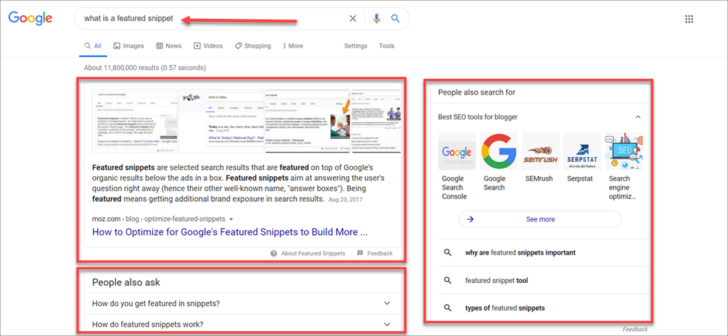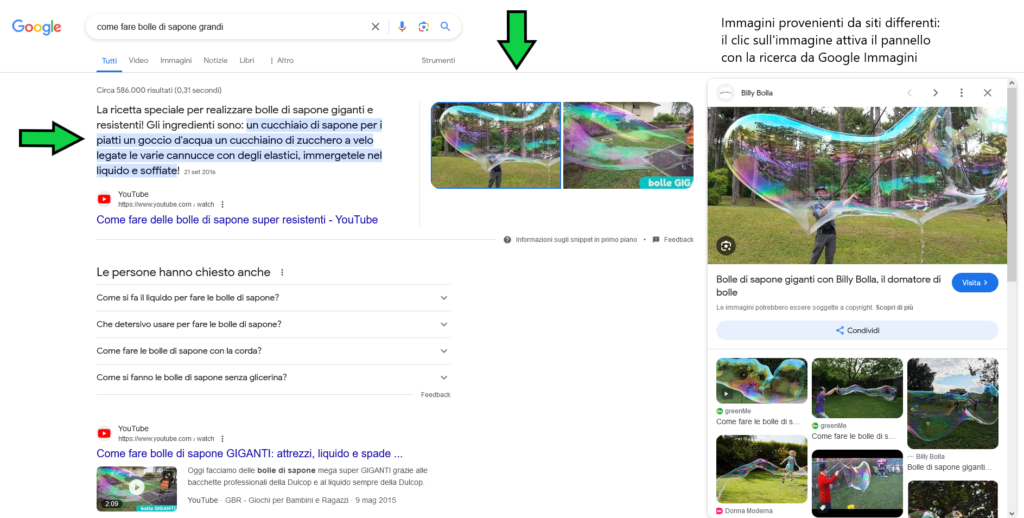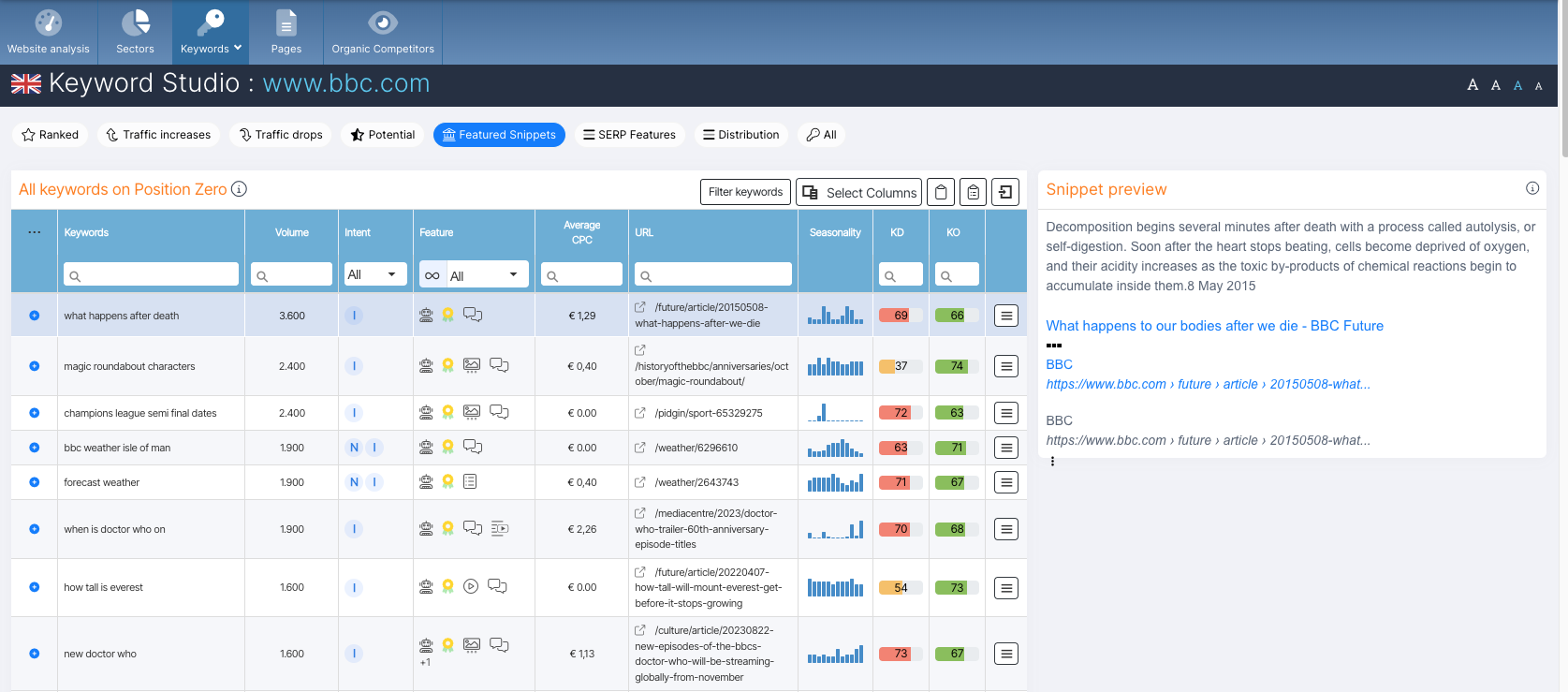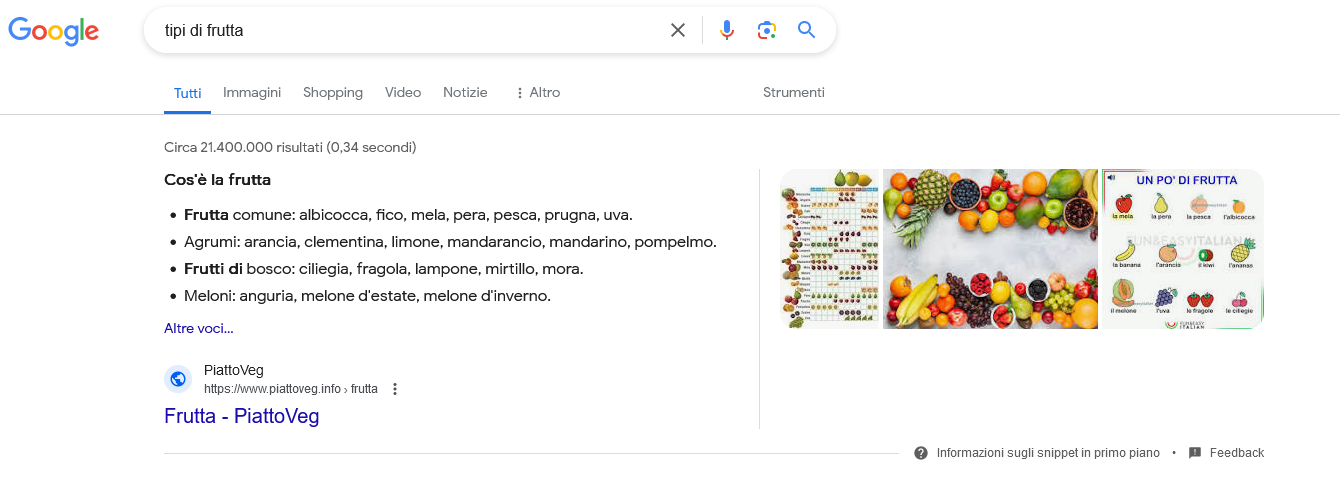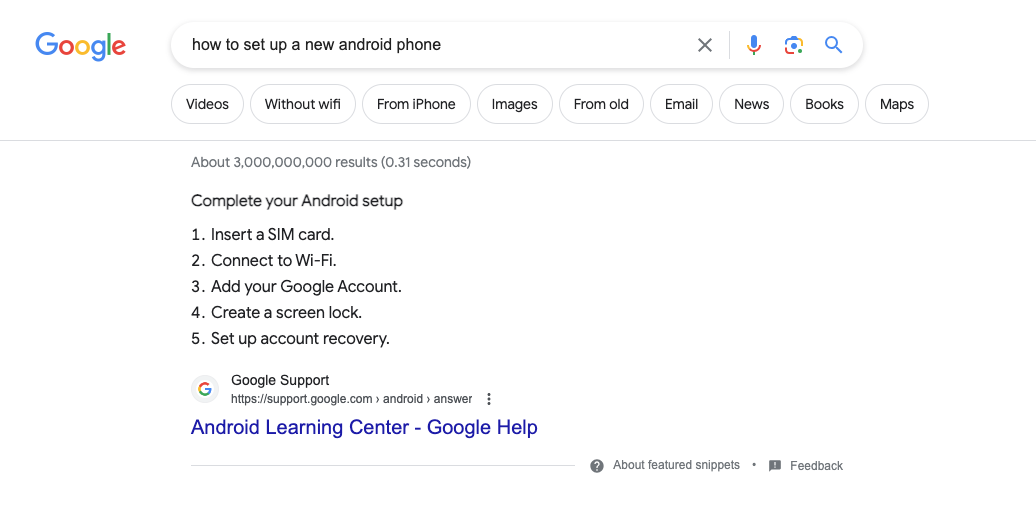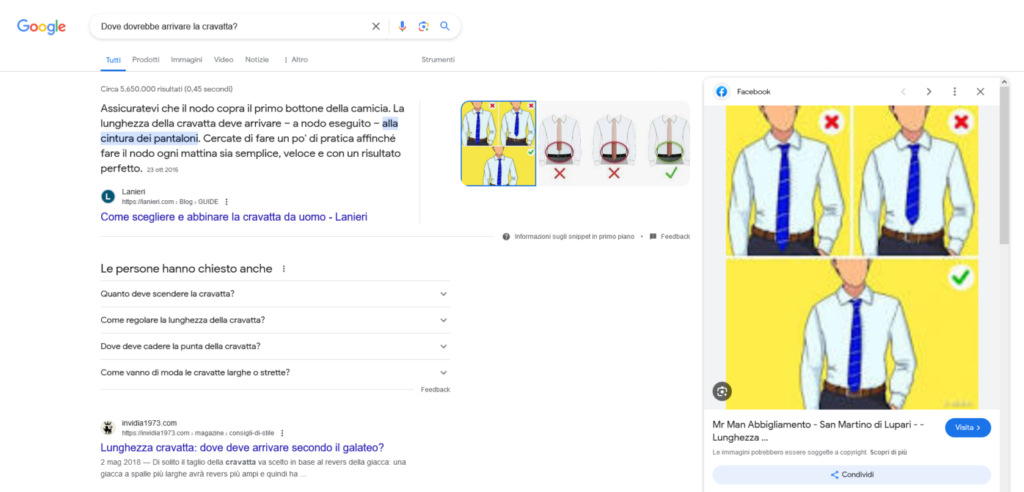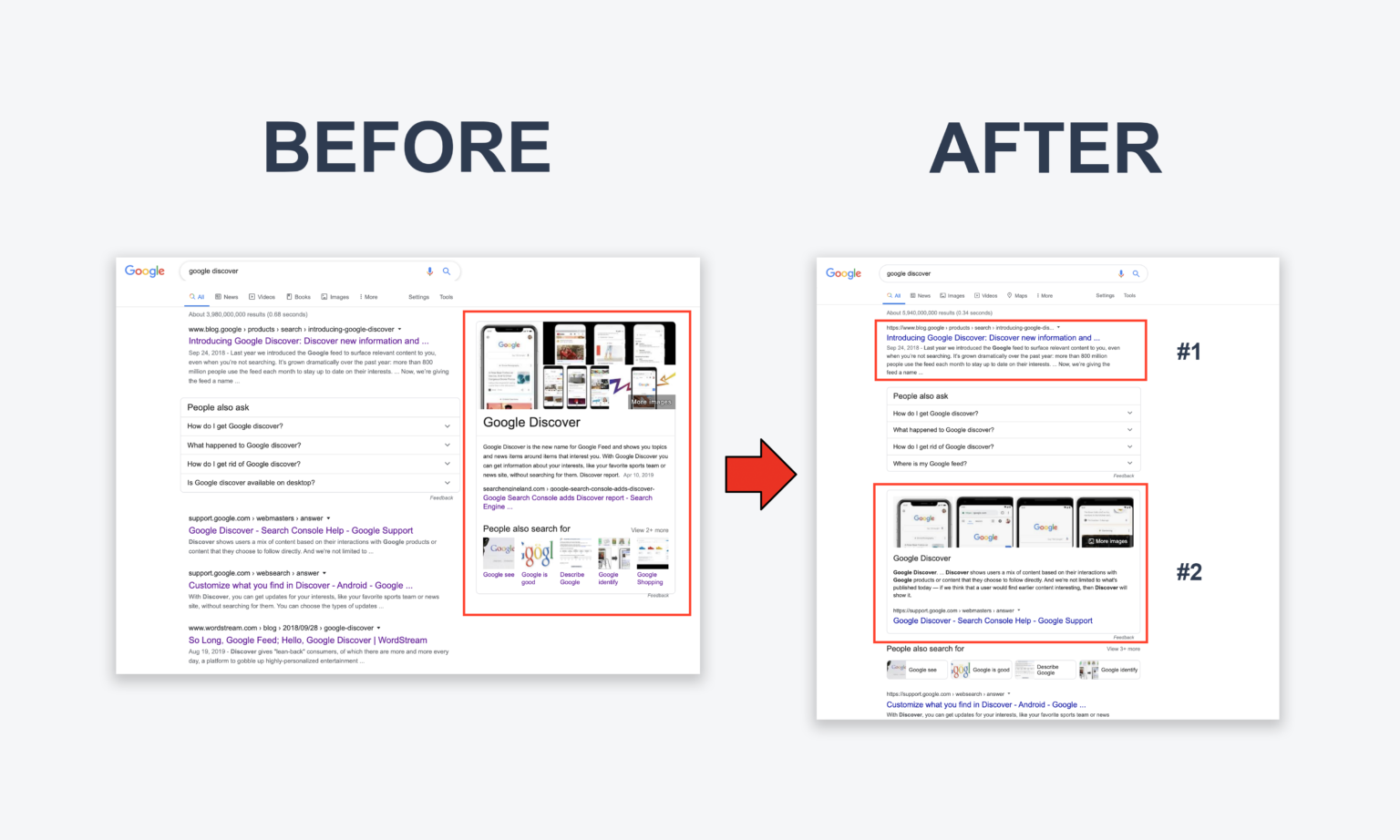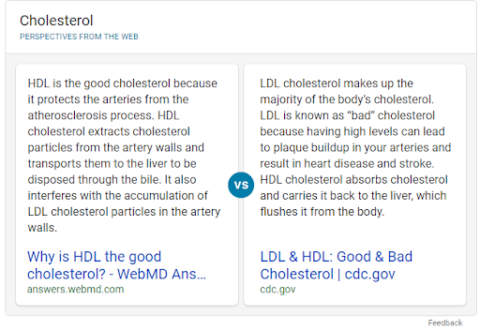Featured Snippet, the complete SEO guide
Loved and hated by SEO specialists, featured snippets represent that privileged section of the SERPs where Google provides immediate answers to users’ questions, and which stand out from the rest of the results for their eye-catching design. A concrete expression of Google’s evolution toward an answer engine, featured snippets are still at the center of a debate between those who precisely love them by appreciating their visibility benefits and those who fear their negative impact on traffic because they erode clicks to the site. So let’s explore the nature of these “special snippets” and strategies for obtaining them to gain a prominent position in search results pages and increase CTR toward the site.
What Google featured snippets are
A featured snippet is a presentation format of search results that Google displays prominently in certain SERPs to directly answer a user’s query.
This snippet is automatically selected by the search engine to provide a quick answer, often without the user having to click on a link. The content of a featured snippet can be a paragraph, a list, a table, or even a video, and is processed differently than standard snippets to make it more readable and immediately understandable.
How many featured snippets does your site have? What about your competitors?
They are called featured snippets because they place attention on the “snippet,” or page description, reversing the usual presentation used by search engines. In fact, as Google explains, normally the description of a page follows the list of links in SERPs, while with featured snippets the content excerpt is highlighted over the rest of the information and shown first.
These snippets literally appear above the traditional organic results, in a privileged position that has generated the name “Position Zero” that we also use in SEOZoom. Featured snippets are also known by the expressions featured snippet or featured snippet, which likewise refer to their main characteristics, which also distinguish them from the classic Google snippets, i.e. the snippets represented by meta description, title and URL.
What featured snippets are used for
Google began introducing featured snippets in 2014: ever since then, their purpose is to immediately answer the user’s query by extracting and displaying a snippet of content directly from the web page that Google deems most relevant. This excerpt is accompanied by the page title, URL, and sometimes an image.
Google uses them to provide quick and direct answers, improving the user experience while giving websites an opportunity to stand out among search results.
Google makes it clear that featured snippets always come from already indexed web search results, and that managing the choice of page and content portion is entirely automatic and dependent on the search engine’s algorithms, which determine precisely what constitutes a valid featured snippet to highlight for a specific search query.
Today, snippets can be found before overall search results, in other areas of the results page, within the “People Also Asked” section or along with Knowledge Graph information, and from the search engine’s perspective, they serve to improve the user experience because users get the information they need without ever having to actually visit a website.
Featured snippets have been one of the strongest signs of the evolution of the search engine, which has also begun to focus attention on those browsing from mobile. Originally, the classic Google results page consisted of 10 blue links pointing to as many resources that the algorithms of the world’s most famous and widely used search engine had deemed valid and reliable, each of which was presented with a small preview, the so-called snippet providing a quick summary of the title and content that would be waiting for us on the page.
For the past few years, this pattern has not been valid, and Google’s SERPs are constantly evolving: not only can additional elements to the search appear (from an image preview to videos, from a featured news box to knowledge graph related searches, with summary and summary content, answers, widgets or other data yet), but also a “zero result,” following the diction SEOZoom uses for this type of content, which is highlighted and prioritized over the other links, scaling as it were before “position one” and emerging independently of the positioning of the various sites within the SERPs, whose order they do not change.
E non è neppure l’ultimo livello dell’evoluzione, perché con la prossima introduzione di Search Generative Experience – il potenziamento del motore di ricerca via Intelligenza Artificiale, che ha già debuttato negli Stati Uniti ed è atteso ancora in Europa – la situazione potrebbe cambiare ulteriormente. Nei primi test, infatti, le risposte di SGE somigliavano a un “super” featured snippet, ancora più carico di informazioni e di elementi che trattengono nella SERP l’utente, che inizia e completa il suo viaggio sempre (e solo?) su Google.
What is the Google’s Position Zero and how it is built
In a nutshell, featured snippets are boxes that, in different forms, appear for many Google searches, providing a precise and direct answer to users’ questions directly in SERPs, without the need to click on a specific result to get the desired information.
In the images below, the part shown with the arrow is called featured snippet, or featured snippet, which is much larger and more detailed than the classic snippets: it is a space that sits at the top of all Google’s first-page placements, with which the search engine offers an initial, concise but comprehensive response to the user’s query, trying to quickly intercept and resolve their search intent.
In addition, Google also uses featured snippets to offer updated results on an evolving topic, as was the case with the orange sky case in California, and thus ensure the validity of the SERPs’ QDF algorithm by offering fresh results.
In its classic form, a featured snippet is built this way:
- A text extracted from a site, with bold type highlighting certain words.
- A title.
- The URL of the page from which the text was taken.
- An image that expands the information content (the image may not even belong to the same URL and usually links to the Google Images search page for the relevant query).
Another useful feature introduced a few years ago on a permanent basis concerns the highlighting and anchoring of onpage text that Google used to create the snippet. The user who clicks on the blue link in the box in SERPs, in fact, lands directly on the part of the page of the site where that reference is, and could potentially miss the entire content of the page itself, dwelling only on the paragraph he was interested in.
Google’s definition of featured snippet
Using Google’s words, “when we recognize that a query is a question, we programmatically identify pages that contain the answer and display the most relevant result in a featured snippet in search results.”
Therefore, as Search Central’s guide points out, the zero-position result, or featured snippet, is essentially a special box or box that contains the answer that Google “deems most accurate in reference to the question posed by a user in Google Search.”
In practice, the search engine’s algorithm immediately offers the answer to the search intent, displaying it “in a special snippet box in the foreground at the top of the search results page,” clearly signaling that it is Web-supplied content, with link back to the page, title and URL clearly visible.
In short, the featured snippet is a box with which Google offers an answer to a query of informational intent (expressed with or without interrogative pronouns and adverbs, i.e., “who, what, where, when, where, why,” and so on) or in some cases commercial (e.g., for insights into the quality of products or services, or to compare two brands or two items for purchase) users by drawing on external resources, selected based on a combination of factors including text length, formatting, page authority, and HTTPS protocol usage.
In just a few lines, Google offers the user exactly what he needs (or what it thinks he searches for), and in fact the first effect of featured snippets is to make the SERP for that particular query superfluous: in most cases, the summary proposed in the zero result turns out to be sufficient to satisfy the person’s intent, who does not have to click on any specific result but possibly his journey of further investigation with other queries.
Featured snippet, where does Google get its answers from?
As mentioned, zero results are taken by Google from third-party sites, cited appropriately with links to the source: Big G’s guidelines specify that they are a summary “programmatically extracted from what a user sees on the web page,” that they “reflect the views and opinions of the site from which they are extracted,” and that the search engine works to improve its “ability to identify the most useful snippets, so the results shown may change over time.”
Until January 2020, sites with featured snippets also had the blue link on the first page of the SERP of the query, and this therefore represented a double opportunity to win users’ clicks. This is no longer the case today because Google has opted for deduplication of results, and thus the site chosen by Google for the featured box no longer has a URL placed among the organic links.
Fun fact: before deduplication, the site chosen by Google for snippet synthesis also appeared in the classic SERP, but it was not necessarily the number 1 result: in many cases, in fact, the snippet was also inferred from results that were originally in second and third positions, or even in fourth (see the case of dorayaki, here in the images).
Google Italy’s favorite sites for featured snippets: data from SEOZoom
As of January 2020, of course, there is no empirical feedback on the original position of the page from which Google extracts the featured snippet, but with SEOZoom we were able to extrapolate some interesting data about Position Zeros on Google Italy (data updated to April 2024).
Analyzing a sample of 10 million keywords, we first discovered that as of today there are 2.5 million keywords on Google.it that trigger featured snippets, in the vast majority for informational intent, although there is no shortage of commercial keywords. In practice, one out of every four searches in Italy shows a zero result, proving what we revealed some time ago with our study on the impact of various features on the visibility of organic results; with keywords pertaining to different sectors in terms of type and nature: from cooking recipes to scientific information, from Sanremo rankings to grammatical definitions or encyclopedic entries, featured results are increasing sharply, with an equally positive forecast trend.
On the podium of sites chosen by Google as sources are Wikipedia, My-Personaltrainer and Treccani. In detail, the Italian version of Wikipedia is the site from which Google extracts the most featured snippets, with over 200 thousand keywords activating this featured snippet space, followed by the health information portal (over 70 thousand occurrences, mainly for keys related to topics related to health, nutrition and lifestyles, with strong authority despite the decline after the March 2024 update) and precisely the site of the famous encyclopedia (almost 50 thousand keywords, mainly for queries related to specific definitions or entries from synonyms and antonyms).
In the top 10 of sites with the most keywords activating featured snippets in Italy we also find Trovaprezzi (more than 40 thousand occurrences for the price comparator, mainly for keys related to price searches or offers on products), the English version of Wikipedia, the sites Humanitas. it and Msd manuals (again for keywords related to the theme of health), the site Aranzulla.it and and then the support pages of Apple and Google, the latter with almost 17 thousand keywords responding in particular to searches related to the search engine itself and, often, to SEO.
How Google chooses the featured snippet
In truth, there do not seem to be any particular identifiable patterns for selection by Google apart from the authoritativeness of the site (general, in the case of Wikipedia, and sectorial in the other examples provided), although the conciseness of the answer and the clarity of the content seem to be important variables for the algorithm, along, of course, with the ranking originally obtained by the page (which must be at least in the top10, not to say in the top3).
The only certainty provided by Google is that there is no way to create a featured snippet or a certain method to place a snippet in the foreground-although there are various studies on how to get a featured snippet-but only one to disable them from one’s own site (with the <meta name=”googlebot” content=”nosnippet”> tag on the page, as we shall see).
Broadly speaking, there are three types of sites that Google draws on for featured snippets: reliable news sites, generalist or niche; highly curated blogs, especially if they have up-to-date content; tutorial and guide sites; and, finally, online newspapers for answers related mainly to very specific events and trends: for example, Repubblica has among its 5200 featured snippets those for results or lineups of soccer matches of past years, information about the Sanremo Festival and various news about gossip and well-known personalities, while Corriere activates about 7500 featured snippets on has lifestyle curiosities, scientific answers and definitions, horoscope or other very varied information (such as laws or news about strikes).
How to discover featured snippets with SEOZoom
In SEOZoom we have two tools and ways to find out if a domain has keywords that trigger a featured snippet in the specific SERP on Google, and then to check for how many, and which, keywords our site or a competitor’s site is ranked with any position zero.
A first method is to enter a project domain and then click on the Keyword Studio section, clicking on the “Zero Results” tab where, precisely, all the featured snippets conquered are listed with an indication of the keyword (and its analysis values, such as search volume, primary intent, SERP features present etc.) and preview boxes of the snippets actually chosen by Google.
The other solution can be used for all sites (and thus not only for project sites) and consists of launching a domain analysis (i.e., enter a domain in full in SEOZoom’s search box) and then clicking on the drop-down menu of the Keyword tab, where the link for the “Featured Snippets” function is located. This opens a page that shows the same information as described before, and then the list of featured snippets conquered by this domain, with an indication of the keyword (and its analysis values) and preview box of the snippets present in SERP.
How featured snippets appear: all types
As mentioned, Google generates different types of zero results to adequately meet the user’s information need: at the macro level, we recognize at least six major categories of featured answers, which differ in form and context.
Specifically, we have:
- Paragraph Featured Snippet – This is the most common form of zero result appearing in SERPs, consisting of generally short text (usually between 45 and 60 words) extracted from pages or articles that offer a concise, timely answer relevant to the intent of the query.
- Bulleted Featured Snippet – The answer in this case is presented in the form of an extendable bulleted list within a box. Such lists are displayed for “How” and “What” questions, but also for searches on rankings, prices, or features of a wide variety of products. List items do not require ranking in any particular or objective order (as in the example for “types of fruit” on Google Italy).
- Numbered Featured Snippet – In this case, Google shows a list numbered in a specific order, relevant to the user’s type of intent: these are either responses on information to be accomplished to achieve the goal (e.g., how-to guides or in some cases recipes) or actual rankings.
- Table Featured Snippet – This is another type popular with Google, which highlights in the box data extracted from a given page displayed in the form of an extensible table. It usually consists of rows and columns displaying values such as prices, rates, years or other numerical data; the tables may already be present within the page selected by Google, but in some cases Google itself dynamically creates that content by extracting the information from the page.
- Video Featured Snippet – In some cases, Google might also show a zero result with videos (usually from Youtube) with a limited timestamp that starts playback in a specific part of the video, in addition to the titles and short descriptions of the media content. This type of featured snippet is decreasing (Google now places embedded YouTube videos in thumbnail form more frequently and directly, activating the key moments feature to aid the search for crucial passages), but examples can still be found in English (including on Google Italy).
- Two for one Featured Snippet – This is one of the most curious situations, where Google combines two resources from different sites. Basically, the box puts together a textual part taken from one site and, next to it, shows an image that instead comes from a different site (as seen in the image below, taken from Google Italy, that show us how to tie your own tie).
The importance of featured snippets for the SEO
Analysts see in this tool a further demonstration of Google’s strategy to increase user retention on SERPs (and not sites), carried out also through answer boxes on more specific and direct queries; when queries are more complex, Google redirects to one of the results provided in SERPs. Because of this, many (especially publishers) initially criticized the novelty, seeing it as a possible enemy of clicks.
In reality, the latest studies reveal that the visibility offered by the featured snippet has positive effects for the site that benefits from it, which, on the contrary, receives more in-depth clicks (compared to even the classic SERP) and, above all, increases the number of page views, as if the user invests the time saved in sifting through the results precisely in browsing Google’s favorite site.
In short, being able to appear in a featured result is good for SEO, and in any case it is a reality to be reckoned with, anyway.
The SEO benefits of featured snippets
We therefore intuit the reasons of those who suggest that possessing a featured snippet is an advantage for the site, which benefits in this way from an over-the-top position in a SERP that responds more immediately to the user’s search, an element that could raise the CTR by prompting the person to delve deeper into the content summarized in the zero result.
Knowing our target audience well means increasing the chances of precisely meeting our potential customers’ expectations through tailored keyword research-in other words, it means creating a content marketing strategy that maximizes the visibility of our content.
One staunch proponent of the SEO and organic traffic benefits of owning featured snippets is Mark Webster, co-founder of Authority Hacker, who some time ago on SearchEngineWatch explained how to analyze and create zero results, showing the structured and repeatable process that allows you to get those positions and take advantage of what he calls an “almost unfair search engine advantage.”
To him, then, it is no coincidence that Google has increased its use of featured snippets, a trend “that doesn’t look like it’s going to change anytime soon,” according to Webster, who believes the search engine will continue to use this approach and keep the balance between “scraping your content (without paying for it) and rewarding you with enough traffic to keep you publishing.”
The value of featured snippets for sites
There is one point to understand: the way visitors interact with the site has changed dramatically. This should not frighten, because it also represents an opportunity: even today, the first position in Google SERPs gives a CTR of more than 30 percent a given search query, which is why dominating that particular slot in the organic SERPs is the goal for all SEOs (and others).
The appearance of a snippet, however, can turn the scenario upside down and divert clicks to Google’s chosen site-which, potentially, in the classic SERP would not have achieved a prominent position: indeed, according to one research about 60 percent of all featured snippets come from sites that did not have position one for that keyword.
How to get featured snippets: the rules and tactics
And so, Webster and his team performed reverse engineering work to determine what are the “rules” behind the appearance of a featured snippet, analyzing more than one million search results to detect commonalities in the “how” and “why” of these rich snippets.
Among the criteria used, all types of featured snippets were included, including YouTube, People Also Ask, Fact Sheets, and more, and only queries that had at least 1,000 searches per month were considered.
The first finding that emerged was that, in general, about 65 percent of all search results include a snippet of some kind, and so, says the author, “if you’re not working to optimize your pages toward these rich/first-ranked snippets, I can pretty much guarantee that your competitors are doing it.”
Identify gaps with competitors’ featured snippets
The first thing we need to do is to find out which keywords on the site could potentially become featured snippets on Google: according to Webster, just start with an analysis of the keywords for which the site is already ranked on the first page on the search engine and see if they generate a snippet in SERP that belongs to a competitor.
It is on these opportunities that we must focus our work to win this featured space that could become profitable for our goals.
At this point, we need to decode the SERPs to understand what guides those premium organic placements, and according to the author there are some commonalities that can be leveraged and applied for our site.
Specifically, “all the talk about using AI and NLP (Natural Language Processing) to determine search results well is basically smoke and mirrors,” or at least still basically hooey, because the process it seems to use is “much more mechanical in nature.”
The optimization work to obtain featured snippets
The data from the study indicate that Google delves into the way content is structured and semantic analysis to figure out what should appear as featured snippets, and we note some basic rules that the algorithm follows when choosing which page to take these snippets from.
In particular (and obviously limited to the U.S. version) there seems to be a preference for pages that structure their data in a very specific way:
- “How to”, “What is” or “Best x vs. y” queries are the best targets.
- The original search query should be placed, verbatim, in an H2 or H3 tag.
- An image should also be included in the “response.”
- Generally, the response should be 50 words in length (no more than 300 characters).
A technique that works (for now)
The process suggested by Webster is somewhat reminiscent of the old content and keyword over-optimization work (especially for exact match in the heading), but according to him it is a technique that still works today and allows information to be structured in a way that causes Google to pay attention to the page.
Like any trick, it is possible that there will be corrective updates from Mountain View that change the selection criteria, but for the time being it works and, the author says, allows you to gain a lot of free organic traffic and outperform your competitors.
How to manage featured snippets on Google
Summarizing again, being featured in a featured snippet can greatly increase a website’s visibility, improving CTR and strengthening its reputation as an authoritative source of information. On the other hand, it can also reduce the number of visits to the page if users find all the information they need directly in the SERP, without having to click through to the site.
That is to say, then, the featured snippet can be a tool to gain traffic through organic positioning and attract the attention of targeted users. In other cases, however, we may find that organic visits have actually dropped due to the presence of the zero result, because its content exhausts the search of users who, further mockery, click on competitor links to read more information.
The big problem is that there is no preemptive way to know the effect of this “visibility” and, at the same time, there is no direct intervention to mark a page as a featured snippet or, conversely, to prevent Google from putting it in that box.
Let’s start with the first aspect: as the new version of the official guide, updated at the end of March 2024, explains, “it is Google’s systems that determine whether a page constitutes a valid featured snippet for a user’s search query and, if so, it is placed at the top.”
There is no direct signal that SEOs, webmasters, publishers or content authors can insert to indicate to Google that they wish to nominate the page for a featured snippet. All we can do is work to increase the chances of appearing in a featured snippet, and then adhere to the prompts to produce content that is useful, clear, well-organized, and directly relevant to user queries; in addition, the use of structured markup schemes can help Google understand and display content more effectively.
Is it possible to block featured snippets?
The other side of the coin also presents difficulties, because it is not really possible to disable featured snippets exclusively, and the avenues we have available lead us to give up other features as well.
There are in fact two ways to block featured snippets, namely setting the “nosnippet” meta tag in the web page code – which, however, also prevents the presence of normal preview snippets in SERPs – or using a max-snippet setting with a low value, which, however, does not give certain guarantees with respect to the “disappearance” of featured snippets. Let’s look at the process in detail.
If we have analyzed the impact of featured snippets on our site – through an evaluation of target keyword rankings, CTR, click-through rate, impressions and conversion data – and discovered through these insights that it would be more convenient to abandon the featured snippet, the way to block the feature and prevent Google from taking and showing our content breaks down into:
- Add the nosnippet meta tag to the page to prevent all the content on the page from appearing in both featured snippets and traditional preview snippets (meta description).
- Use the data-nosnippet tag inline with span, div, or section HTML elements to prevent that specific text from appearing in either type of snippet.
- To block featured snippets but not text snippets in SERPs we can try setting the max-snippet tag, which is used to specify the maximum number of characters that can be displayed on Google.
Featured snippets are in fact displayed only if Google is allowed to show enough text to generate useful content. The suggestion is to reduce the value until you find the cut-off point for which Google continues to display pages for featured snippets: generally, the lower the value of the max-snippet rule setting, the less likely the page will be shown as a featured snippet.
Google does not provide an exact minimum length required for display as a featured snippet because the minimum length varies depending on a number of factors including (but not limited to) the information in the snippet, the language, and the platform (mobile device, app, or desktop).
One idea might be, for example, to set a 170-character limit, which is sufficient for Google to show our meta descriptions, but not for larger content (as featured snippets typically are) to appear. However, it is the same guide that anticipates that this technique and of a max-snippet setting with a low value does not prevent with certainty that the content is used for a featured snippet, which is why it is preferable to use the nosnippet tag, called the “certain solution” to prevent Google from showing featured snippets for our page.
How many featured snippets are on Google
In recent years, there have been multiple experts who have tried to study and quantify the phenomenon: according to some estimates, 65 percent of organic searches on Google include at least one rich snippet, and users are increasingly becoming accustomed to this feature, even adjusting their gaze to go along with the Google pinball effect.
An article published in Search Engine Journal by Lily Ray, Director of SEO at Path Interactive, traces the changes made by Google and offers insights for site content optimization, reporting that 24 percent of search results show a featured snippet, while moving to mobile about 80 percent of voice search results on the search engine come from featured snippets.
Among the various forms of featured snippets, bubble refinements or carousels play a prevalent role, the carousels that debuted in 2018 and are displayed in about 9 percent of queries that produce a result with featured snippets. This type offers users the ability to refine their search based on a set of modifiers commonly searched for in association with their original query: these are often names, locations, or product attributes of competing brands and allow several URLs to simultaneously own the featured snippet.
This system also takes advantage of the use of Google BERT, the neural network technology that can process natural language launched in 2019, which enables Google to better understand complex queries, improve text comprehension, and thus also modify the answers provided via the featured snippet content.
Considerations on the value of featured snippets for SEO
The farewell to results deduplication has further challenged the value of the feature for SEOs. That is to say, is it more strategic to gain featured snippets or try to reach the mythical No. 1 position in organic results?
The answer actually depends on a number of factors – such as the types of queries, intent and content present in the snippet-because these determine whether featured snippets can produce a zero-click result or the click-through rate could be significantly higher than with regular blue links.
Thus, is Lily Ray’s thesis, “not being able to rank in both places (snippet and classic SERP) could result in potential declines in traffic“, but the final decision on whether to also choose featured snippets as a target for SEO work should be made on a case-by-case basis, evaluating keyword ranking, CTR, click-through, impression and conversion data.
Also because, as is evident from the numbers proposed earlier, if it is not our site that stands out in a featured snippet, it will be that of a competitor.
Google’s latest news on featured snippets
To understand the SEO value of featured snippets, we also need to be abreast of Google’s evolutions with regard to this feature; for example, in the period following deduplication we had a phase with examples of links moved to the second page or elsewhere, while now it seems that Google has chosen (permanently?) to eliminate the second link to the site.
Thus, for queries where they are activated, the featured snippet essentially becomes a “result one,” in a more prominent position, with more preview text (which often complements the user’s interest and answers their question, usual problem) and links to the site still visible.
Pay attention to the location, however, because the other change that has been noticed in the past months concerns precisely the location of the box: in addition to classically finding it at the top, in fact, in some cases the snippets were located in the middle of the page or at least below other organic results, with a much less impactful visual effect on the user (see the example reported by Brodie Clark).
Featured snippets and YMYL content
Another aspect to be explored concerns the type of content that “triggers” featured snippets, because not all topics have the same “weight” in terms of attention, and in particular for topics related to science and health Google has from the outset set out guidelines to regulate the unambiguous requirements that a text must meet in order to appear in featured snippets. To put it more simply, the text must not be sexually explicit, violent, dangerous, inciting hatred, harmful, or provide a version that contradicts the consensus on topics of public interest, on pain of removal from the SERPs or user reports.
Building on this, Path Interactive’s SEO team set out to delve into a variety of featured snippet results, particularly for the queries “Your Money Your Life” (YMYL), to see if there are any insights into the relationship between the nature of featured snippet content, content quality, and Google’s EEAT parameters.
The first step in this study focused on controversial topics and served to understand whether Google generates featured snippets for highly controversial topics, in comparison to Bing‘s feature that handles such topics with “multi-perspective answers,” answers from multiple perspectives. Microsoft’s search engine tries to show various viewpoints for topics that do not have a single correct answer in various fields.
The first example provided concerns a health-related question, the question “Is cholesterol good?”: while Bing offers an analytical answer from multiple sources (discussing good and bad cholesterol from a scientific perspective), Google selects content from only one site and seems to leave out pieces of information that could help the user better understand why cholesterol can be both good and bad at the same time.
The images, again from SearchEngineJournal.com, give us a better understanding of the two approaches.
The differences are exacerbated for more controversial queries, such as “climate change is real” or “abortion is murder,” for which Google decides not to show any featured snippets. In contrast, Bing introduces the problematic topic and leans toward an answer (climate change is real, in the first case, and abortion is not murder, in the second).
The study on Content readability
In the second phase, the team collected a sample of 419 YMYL queries generating a featured snippet, extracted content from those snippets, and used the Readable.io tool to analyze their readability, other parameters, and the content of the pages from which they were taken.
Do your keywords trigger featured snippets?
At the end of this study, it was found that 78 percent of the YMYL-themed featured snippets had readability scores between B and E (on a scale where A indicates extremely readable and E as unreadable) and an average Flesh-Kinkaid readability level of 10. This seems to indicate that such content is at a slightly higher level and difficult to read than the full pages from which it is extracted.
In addition, 13 percent of the content analyzed received a sentiment score of “negative” and 23 percent received a sentiment score of “neutral,” differing significantly from the analysis of the full page content, which was almost entirely rated as “positive.” This factor could depend on the very nature of the featured snippet content, which often offers direct advice on stressful medical or financial topics, such as symptom control or seeking help with debt reduction.
As for the pages Google selects to tap into a featured snippet for YMYL queries, the average content is long (over 1,600 words), readable by a wide audience, positive in its sentiment and formal in its tone. These characteristics are not surprising, as they also meet the broader levels of quality required for ranking on Google (which generally pulls featured snippets from pages already ranked in the Top10), which requires treatment (and thus longer length) to cover YMYL topics adequately.



